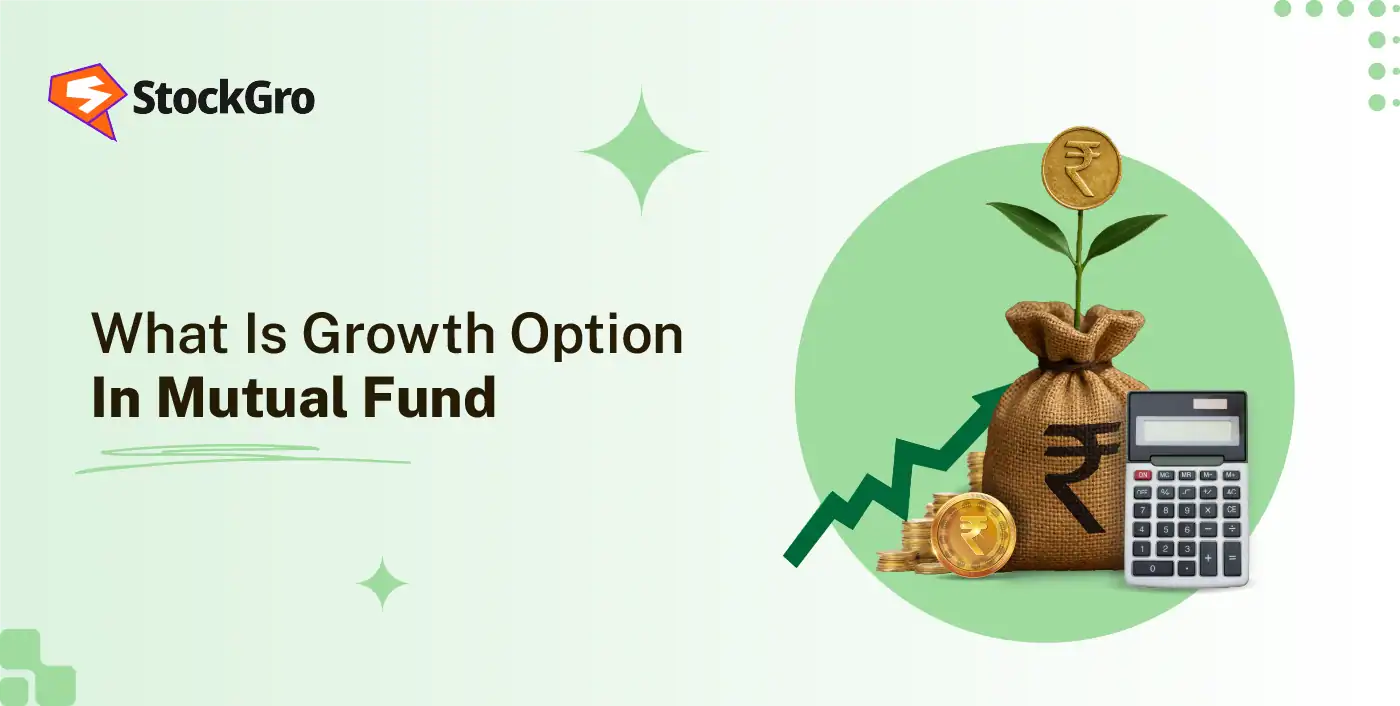
Despite the sevenfold growth in India’s mutual fund assets over the last decade, investors often struggle with an important choice: whether to go for the dividend option or the growth option. This decision can significantly impact long-term returns and the power of compounding. This blog will explain why the growth option is the smarter answer, discussing what is the growth option in a mutual fund,how it works, and why you should choose it.
What Is Growth Option in a Mutual Fund?
The growth option within a mutual fund is an investment plan where the profits earned by the fund, such as dividends or gains, are not shared with investors. Instead, these earnings are automatically reinvested back into the scheme. This continuous reinvestment leads to an increase in the Net Asset Value (NAV) of the fund’s units over time. Investors who choose this option do not receive regular payouts but can potentially benefit from the power of compounding, which can lead to significant wealth creation over the long term.
How It Works
In the growth option, profits earned by the fund are automatically reinvested, increasing the number of units you hold rather than being paid out. This reinvestment allows your investment base to expand over time, and future returns are calculated on this larger base, creating a compounding effect. Gains are only collected when you redeem or sell your units.
For example, if you invest ₹50,000 for 10 years at an annual return of 12%, the future value (FV) can be calculated using the formula:
FV = PV × (1 + r)^n
Where:
- FV represents the future worth of the investment
- PV is the present value or the initial investment amount
- r refers to the projected return rate per investment period or year
- n is the number of periods for which the investment is made
FV = ₹50,000 × (1 + 0.12)^10 = ₹1,55,299
This shows how the initial investment grows over the specified period due to the effect of compounding, without any additional investments from the investor.
Growth vs. Dividend (IDCW) Options
The main differences between the growth vs dividend option (now known as Income Distribution cum Capital Withdrawal or IDCW) are as follows:
| Aspects | Growth option | IDCW (dividend) option |
| How earnings are managed | Fund profits are reinvested, increasing overall value. | Profits are distributed periodically as dividends. |
| Tax treatment | Tax applies only at redemption, allowing deferred growth. | Taxed both during payout and at redemption. |
| Impact on NAV | NAV steadily rises as earnings stay invested. | NAV falls after each dividend distribution. |
| Income flow | No regular income. Gains collected on redemption. | Provides recurring income through payouts. |
| Effect on compounding | Full compounding benefit as returns are reinvested. | Reduced compounding due to frequent withdrawals. |
Important note: Switching from IDCW to growth option in mutual funds is possible by a ‘switch’ transaction or by redeeming IDCW units and buying growth units. Switching is treated as redemption+payout and may attract capital gains tax, check fund terms. If switching before the specified lock-in period, exit load may apply.
Advantages of Growth Option
The primary advantages of the growth option in a mutual fund include:
- Focus on capital appreciation: The main objective of the growth option is capital appreciation. By reinvesting the profits, it aims to grow the investor’s capital significantly over the long term.
- Channeling the snowball effect: Reinvesting profits helps returns create additional earnings, resulting in steady growth over years.
- Augmenting return potential: Due to the compounding effect, the growth option has the potential to generate higher returns compared to the dividend option over the long run, as the entire corpus remains invested and continues to grow.
- Tax-deferred growth: In the growth option, taxes are only payable at the time of redemption. This deferral of tax allows the investment to grow without being diminished by annual tax payouts on dividends. Long-term capital profits are usually taxed at a lower percentage than dividend income, which is taxed as per one’s income bracket.
- Encouraging investment discipline: Since there are no regular payouts, the growth option encourages a disciplined approach to investing, helping investors to stay invested for the long term and avoid the temptation to spend the earnings.
Tax Implications & Efficiency
The tax liability and efficiency of growth option in mutual funds are governed by the following rules:
- In the growth option of mutual funds, investors do not receive dividends during the holding period; instead, the gains are reinvested, and tax is applicable only when units are redeemed or switched.
- For equity mutual funds with at least 65% invested in equities, short-term capital gains (STCG) tax is 20% if redeemed within one year, and long-term capital gains (LTCG) tax is 12.5% on gains exceeding ₹1.25 lakh after holding for more than one year.
- For debt or hybrid funds (less than 65% equities), for investments made on or after April 1, 2023). All capital gains, regardless of the holding period, are treated as short-term capital gains (STCG). These profits are included within your total income and taxed according to your tax bracket. The concept of LTCG and the benefit of indexation have been removed for new investments in these funds.
- When you redeem or sell units of an equity-oriented mutual fund (including the growth option), an STT of 0.001% is levied on the total sale value. This tax is withheld by the asset management company during redemption. STT is not applicable to the redemption of debt mutual fund units.
- The growth option is generally considered tax-efficient compared to the dividend option, as dividends are taxed when received and subject to TDS.
Who Should Choose a Growth Option?
The growth option is suitable for certain types of investors, such as:
- Those with long-term objectives: Investors with multi-year financial goals can opt for the growth option to steadily build a larger corpus, allowing their wealth to grow in line with future needs such as retirement or education planning.
- Those comfortable with market volatility: Growth funds typically invest in equities, which are subject to market fluctuations. Therefore, this option is suitable for investors who have a higher risk tolerance and can withstand short-term market fluctuations.
- Investors focused on accumulation: Those whose primary financial goal is to accumulate wealth over a period and who do not require a regular income stream from their investments would find the growth option to be an appropriate choice.
- Investors early in their career: Investors who are in the early stages of their careers have a longer time to stay invested and can afford to take on more risk for potentially higher returns, making the growth option an ideal choice for them.
Drawbacks or Consideration
While the growth option offers various benefits, there are also some drawbacks and considerations to keep in mind, including:
- Market risk: The valuation of growth funds is directly dependent on how the underlying assets perform, often equities. This exposes the investment to market volatility, and there is a possibility of capital erosion, especially in the short term.
- No regular income: This option does not provide any regular cash flow. For investors who depend on their investments for a steady income, such as retirees, the growth option may not be suitable.
- Requires patience: The benefits of the growth option, particularly the power of compounding, are realised over a long period. Investors need to be disciplined and remain invested across market phases to gain potential benefits over time.
- Lump-sum tax liability: While tax is deferred, a major tax liability may arise at the time of redemption, especially if the investment has grown substantially. This is something every investor should plan ahead for.
- Capital gains tax: When the units are redeemed, profits are liable for capital gains tax. The tax rate varies based on the holding term and whether the fund type is equity or debt.
Global vs. India-Specific Context
Here is a detailed comparison of the growth option in mutual funds from a global perspective versus the Indian, including key applicable rules, figures, and regulations:
| Aspect | Global | Indian |
| Regulatory authority | Regulated by respective countries’ financial authorities (e.g., The US Securities and Exchange Commission (SEC) in US, the Financial Conduct Authority (FCA) in UK) with frameworks varying by country. | Regulated primarily by SEBI (Securities and Exchange Board of India). |
| Terminology | Sometimes referred to as “accumulation” or “growth” options, with reinvestment of earnings. | Officially “growth option” where dividends are reinvested rather than paid out periodically. |
| Taxation rules | US: Dividends are taxable unless reinvested, capital gains taxed per holding period status; reinvestment is common but taxed upon redemption. Europe & UK have differing dividend taxation rules with emphasis on withholding taxes and gains tax. | Capital gains tax applies on redemption; dividends are now taxable in investor hands (post-abolition of dividend distribution tax). Different LTCG/STCG rates depending on equity or debt classification. |
| Holding period | Vary widely by jurisdiction for long-term capital gains benefits (e.g., US LTCG qualifying period is >1 year). | Indian LTCG is after 12 months for equity mutual funds, 36 months for debt funds (changing to 24 months for some categories from FY 2025-26). |
| Disclosure and transparency | Regulations often require detailed disclosure on dividend reinvestment, fund NAV, and capital gains impact to investors. | SEBI mandates disclosures on NAV, portfolio holdings, cost structure, and investor rights; has enhanced disclosure requirements over the past decade to protect retail investors. |
| Availability of options | Globally, funds offer accumulation vs distribution classes for investors with choice of reinvestment or cash payouts. | Growth option is a key choice in Indian mutual funds alongside dividend or IDCW (income distribution cum capital withdrawal). |
| Operational rules on reinvestment | Typically automatic reinvestment of dividends into additional units or shares; investor choice common. | Similar reinvestment mechanics, but fund NAV reflects reinvestment under growth option; dividend payouts create NAV drop. |
| Market size and growth | US mutual fund assets are predicted to reach $38 trillion by 2030, with growth options widely used for capital appreciation. | Indian mutual fund AUM is predicted to reach $1.2 trillion by 2030 with rapid growth but on a much smaller scale. |
Conclusion
In essence, knowing what is growth option in a mutual fund is about choosing long-term wealth creation over immediate income. By reinvesting all profits, it uses the power of compounding to build a larger corpus for your future. This makes it the ideal path for investors focused on achieving significant financial goals down the road.
FAQs
The growth option reinvests the profits back into the mutual fund, increasing its NAV and enabling compounding. In contrast, the dividend option pays out earnings periodically to investors, reducing the NAV. Growth focuses on capital appreciation, while dividend provides regular income.
Growth options offer tax efficiency because taxes are deferred until you redeem units, allowing your investment to grow unhindered by interim tax payments. Dividends under the dividend option are taxed as per the investor’s income slab when paid, which is less efficient over time.
Growth options suit investors with long-term financial goals who do not require regular income. These are often early-career investors or those focused on wealth accumulation, willing to tolerate short-term volatility to maximise capital appreciation through compounding over time.
Yes, investors can switch from the IDCW/dividend option to the growth option within the same mutual fund, typically without tax implications if treated as a transfer. This flexibility allows investors to adjust their strategy based on changing financial goals or market conditions.
The growth option is generally preferable for long-term investing as it includes compounding by reinvesting earnings, enhancing the potential for capital appreciation. It avoids the drag of periodic dividend payouts and taxes, offering greater overall wealth creation over time.
Growth options don’t provide periodic income, which may be unsuitable for investors needing cash flow. They require patience, as benefits emerge over longer terms. Also, a lump-sum tax liability arises upon redemption, which can be significant if the investment has appreciated substantially.

